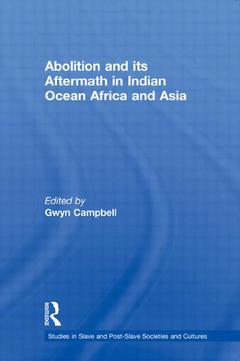Description
Abolition and Its Aftermath in the Indian Ocean Africa and Asia
Routledge Studies in Slave and Post-Slave Societies and Cultures Series
Coordinator: Campbell Gwyn
Language: English
Subject for Abolition and Its Aftermath in the Indian Ocean Africa...:
Keywords
slave; trade; persian; gulf; debt; bondage; east; labour; trucial; coast; Indian Ocean Slavery; Young Man; Freed Women; Colonial Administrations; Muslim World; Indian Ocean Africa; Ile De Bourbon; Bel Ombre; Trucial Coast; Western Indian Ocean; Filipino Nationalist; Anti-slavery Ideology; Ibn Saud; Assam Tea Plantations; Tea Plantations; Nineteenth Century Slavery; Anti-slavery Laws; General Leonard Wood; Philippine Assembly; Unfree Labour; Debt Slaves; Mauritian Planters; Perpetual Slaves; Workman’s Breach; South African Commercial Advertiser
Publication date: 09-2012
Support: Print on demand
Publication date: 07-2005
· 15.6x23.4 cm · Hardback
Description
/li>Contents
/li>Readership
/li>Biography
/li>Comment
/li>
This important collection of essays examines the history and impact of the abolition of the slave trade and slavery in the Indian Ocean World, a region stretching from Southern and Eastern Africa to the Middle East, India, Southeast Asia and the Far East.
Slavery studies have traditionally concentrated on the Atlantic slave trade and slavery in the Americas. In comparison, the Indian Ocean World slave trade has been little explored, although it started some 3,500 years before the Atlantic slave trade and persists to the present day. This volume, which follows a collection of essays The Structure of Slavery in Indian Ocean Africa and Asia (Frank Cass, 2004), examines the various abolitionist impulses, indigenous and European, in the Indian Ocean World during the nineteenth and twentieth centuries. It assesses their efficacy within a context of a growing demand for labour resulting from an expanding international economy and European colonisation.
The essays show that in applying definitions of slavery derived from the American model, European agents in the region failed to detect or deliberately ignored other forms of slavery, and as a result the abolitionist impulse was only partly successful with the slave trade still continuing today in many parts of the Indian Ocean World.
1. Introduction Gwyn Campbell 2. Indian Ocean Slavery and its Demise in the Cape Colony Nigel Worden 3. The Bel Ombre Rebellion: Indian convicts in Mauritius, 1815-53 Clare Anderson 4. Abolition and its Aftermath in Madagascar, 1877-1949 Gwyn Campbell 5. Abolition and its Impact on the Benadir Coast Omar Eno 6. Slavery and the Slave Trade in Saudi Arabia and the Persian Gulf States, 1920s-1960s Suzanne Miers 7. The "Shari'a and the Anti-Slave Trade "Farman" of 1848 in Iran Behnaz Mirzai 8. The Slave Trade and its Fallout in the Persian Gulf Abdul Sheriff, Advisor, Zanzibar Museums 9. Abolition by Denial? Slavery in South Asia after 1843 Indrani Chatterjee 10. Plantation Labour in the Brahmapura Valley: Regional enclaves in a colonial context, 1881-1921 Keya Dasgupta 11. Colonialism, Nationalism and the Meaning of Slavery: The genealogy of "an insult to the American government and to the Filipino people" Michael Salman 12. Islamic Attitudes towards the Abolition of the Slave Trade and Slavery in the Indian Ocean, c1800-c1940 W.G. Clarence Smith 13. The Emancipation of Slaves in the Indian Ocean Martin Klein
Gwyn Campbell is a History Professor at McGill University. He initiated the series of Avignon conferences on Slavery and Forced Labour and has published widely on slavery, the slave trade and other aspects of forced labour including The Structure of Slavery in Indian Ocean Africa and Asia (Frank Cass, 2004).
These books may interest you

The Routledge History of Slavery 64.97 €



